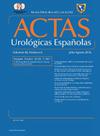Seguridad y viabilidad de la cirugía retrógrada intrarrenal sin fluoroscopia para la litiasis ureteral y renal no complicada: estudio unicéntrico en una serie amplia de pacientes
IF 1.2
4区 医学
Q3 UROLOGY & NEPHROLOGY
引用次数: 0
Abstract
Introduction
Aimed to investigate the feasibility and availability of fluoroless retrograde intrarenal surgery (fRIRS) in a large patient population.
Methods
Patients who underwent fRIRS for ureteral or renal calculi in our center between June 2019 and June 2024 were reviewed. Demographic data, stone characteristics, operation time, perioperative-postoperative complications, perioperative complications, and stone-free rates of patients who underwent fRIRS for ureteral or renal calculi were evaluated. Clavien-Dindo classification was used for complications. All procedures were performed under spinal or general anesthesia.
Results
1079 patients were included in the study. Of the 1079 patients, 352 (32.6%) were female and 727 (67.4%) were male. The mean age was 47.33 ± 14.31 years. The mean size of the stones was 13.1 ± 6.33 mm3. Of the patients, 208 (19.27%) received general anesthesia and 871 (80.73%) received spinal anesthesia. The mean operation time was 37.14 ± 17.65 minutes. All patients received a Double J (DJ) stent postoperatively. The rate of complications was 8% overall. The complications observed in general were minor; postoperative colic pain and hematuria were observed in 36 (3.3%) patients and 26 (2.4%) patients, respectively. Stone-free rate was 86.4%.
Conclusion
The fRIRS is a safe and feasible method for the treatment of uncomplicated ureteral and renal calculi. In uncomplicated patients, it has similar complication and success rates to conventional methods and eliminates radiation exposure.
无荧光肾内逆行手术治疗简单的尿路和肾石症的安全性和可行性:一项多组患者的单中心研究
目的探讨无氟逆行肾内手术(fRIRS)在大量患者中的可行性和可用性。方法回顾本中心2019年6月至2024年6月期间因输尿管结石或肾结石接受fRIRS治疗的患者。对输尿管结石或肾结石行fRIRS治疗患者的人口学资料、结石特征、手术时间、围手术期-术后并发症、围手术期并发症和结石无结石率进行评估。并发症采用Clavien-Dindo分型。所有手术均在脊髓或全身麻醉下进行。结果1079例患者纳入研究。1079例患者中,女性352例(32.6%),男性727例(67.4%)。平均年龄47.33±14.31岁。结石的平均大小为13.1±6.33 mm3。全麻208例(19.27%),脊髓麻醉871例(80.73%)。平均手术时间37.14±17.65 min。所有患者术后均行双J (DJ)支架置入。并发症发生率为8%。观察到的并发症一般较轻;术后腹痛36例(3.3%),血尿26例(2.4%)。脱石率为86.4%。结论fRIRS是一种安全可行的治疗无并发症输尿管结石和肾结石的方法。在无并发症的患者中,它具有与传统方法相似的并发症和成功率,并且消除了辐射暴露。
本文章由计算机程序翻译,如有差异,请以英文原文为准。
求助全文
约1分钟内获得全文
求助全文
来源期刊

Actas urologicas espanolas
UROLOGY & NEPHROLOGY-
CiteScore
1.90
自引率
0.00%
发文量
98
审稿时长
46 days
期刊介绍:
Actas Urológicas Españolas is an international journal dedicated to urological diseases and renal transplant. It has been the official publication of the Spanish Urology Association since 1974 and of the American Urology Confederation since 2008. Its articles cover all aspects related to urology.
Actas Urológicas Españolas, governed by the peer review system (double blinded), is published online in Spanish and English. Consequently, manuscripts may be sent in Spanish or English and bidirectional free cost translation will be provided.
 求助内容:
求助内容: 应助结果提醒方式:
应助结果提醒方式:


